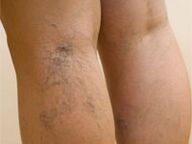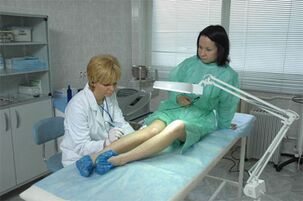
Varicose veins (or varicose veins) of the legs is a fairly common disease. Mostly women between the ages of 30 and 60 fall victim to it, especially if they suffer from diabetes or are overweight and have posture problems. In addition, these people suffer from varicose veins, whose work requires them to be upright or sitting for a long time. Unfortunately, the number of cases is increasing every year. That is why it is important to know not only how to treat varicose veins in the legs, but also how to avoid it.
Causes
Treatment of varicose veins, in the first place, should be to remove the immediate cause of its appearance. Below are the most common in everyday life:
- Be upright or sitting for a long time;
- Overweight (obesity);
- Increased pressure in the veins of the lower extremities due to heavy loads during constipation, weight lifting and pregnancy;
- Congenital or post-traumatic absence of venous valves in the vessels of the lower extremities.
Varicose veins of the legs can be cured only after getting rid of all the above factors. Otherwise, recurrence of the disease cannot be avoided.
Symptoms
One of the most important signs of varicose veins is the appearance of bulging and nodular swellings in the veins of the lower extremities. Often this is accompanied by severe pain and heaviness in the legs, an unpleasant burning sensation can be added. In severe cases, episodic cramps and swelling may occur, which usually appear in the late afternoon. A characteristic feature of varicose veins is the gradual thickening and darkening of the skin of the lower leg.
If left untreated, the walls of the affected vessels become inflamed and clogged with multiple blood clots. Over time, ulcers can develop on the skin. In most cases, such a development leads to quite frightening diseases, such as thrombophlebitis or thrombosis.
In what situation should you see a doctor?
Varicose veins develop gradually, but sometimes progress quite quickly - in such cases you can not hesitate to see a doctor. The acute course of the disease is characterized by the following symptoms:
- Acute pain that reaches such an intensity that a person cannot move on his own. This is accompanied by a feeling of warmth and hardening of the skin of the feet;
- Shortness of breath, feeling weak and short of breath;
- Bleeding located in the immediate vicinity of the affected venous vessels or by themselves.
Diagnostics
When the first signs of varicose veins appear, you should seek help from your doctor. As a rule, after conducting standard examinations (examination, anamnesis, CBC, OAM), he refers such patients to a specialist in vascular diseases (phlebologist) or immediately to a vascular surgeon.
In addition to the basic diagnostic measures, they can be prescribed:
- Ultrasound of veins (duplex scan);
- Contrast venography.
Treatment
Today there is no remedy for varicose veins that can give a 100% result. Treatment should be comprehensive, using both surgical and therapeutic techniques.

Conservative treatment
Fighting varicose veins with the help of conservative methods is possible only in cases where the symptoms are just beginning to appear and it is not necessary to talk about possible complications. The main components of this treatment are:
- Diet;
- Set of special exercises;
- Compression therapy;
- Drug therapy.
Diet
As mentioned earlier, varicose veins mainly affect those overweight people. In this regard, one of the conditions for successful treatment is undoubtedly the observance of a proper diet aimed at destroying excess weight. There are many variations on how to compose your daily diet, but none of them should be followed without first consulting your nutritionist.
As a rule, such diets include avoiding any sweets, as well as those foods that contain large amounts of plant fiber.
Physical training
Physiotherapy exercises are an excellent remedy for varicose veins of the legs. There are a number of special exercises that can be performed to significantly slow the progression of the disease, and sometimes completely get rid of it. Also, do not forget about outdoor walks (morning and evening) and swimming.
Important!In case of varicose veins, you should refrain from going to the sauna, bath, do not take too hot a bath and do not lift your legs. This is due to the fact that with these procedures the blood flow to the limbs is significantly increased, where stagnation is already observed in varicose veins.
Compression therapy
The treatment of varicose veins at home involves the use of special T-shirts in the form of golf, socks and tights, as well as elastic bandages of different lengths. As a rule, doctors recommend wearing them throughout the day and taking them off only before bedtime.
In this way, it is possible to significantly increase the tone of the veins and improve blood flow to the legs. And this in turn helps to eliminate the symptoms of the disease. Also very useful foot massage for varicose veins, which should be performed by a specialist.
Drug therapy
Today, drugs for the treatment of this disease are widely available on the pharmaceutical market. In addition, gel, ointment and foot cream for varicose veins are used together with the tablet forms. All of them can significantly reduce the rate of disease progression and even prevent the development of some complications.
However, we must not forget that each medicine should be used only as directed by a doctor. After all, almost all of them have quite a few contraindications and improper use can lead to unforeseen situations.
Most often in varicose veins of the lower extremities doctors prescribe drugs from the following groups:
- Anti-inflammatory drugs;
- Venotonics - drugs that increase the tone of the veins and improve venous outflow;
- Preparations aimed at reducing blood viscosity and preventing the formation of blood clots.
Surgical treatment
Surgery is the most radical method used in situations where all alternative methods of control do not give any positive results.
The most common surgery involves making small incisions in the skin and removing the affected veins through them. After the operation, the legs are tightly bandaged. After a few hours, patients can move on their own.
Nowadays, the technique of removing pathologically altered veins with the help of a laser is becoming more widespread. Such an operation is less traumatic, but after it recurrences of the disease are often observed.
Prevention
Undoubtedly, like most modern diseases, varicose veins are easier to prevent than to treat. That is why doctors recommend starting prevention of this disease from the earliest years. To do this, do the following:
- Play sports actively;
- During constant work you should periodically take breaks (walk on your toes, then on your heels);
- You should take a cool shower after a workout;
- Special T-shirts should be worn during pregnancy, especially in the later stages.























